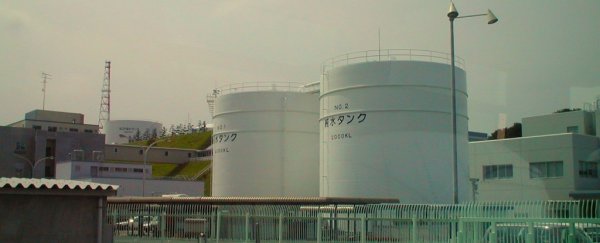We all remember 11 March 2011, when the magnitude 9.0 Great East Japan earthquake triggered a 14-metre tsunami that flooded the Fukushima Daiichi nuclear power plant.
Four of the six reactors on site were badly damaged, three suffering core meltdowns.
Also affected by the tsunami, but to a much lesser extent, were the four reactors at the Fukushima Daini nuclear power plant, roughly 11 km further south. That site was partially flooded, but sufficient safety systems were still available to shut down and cool the reactors safely.
At 5.59am local time on Tuesday the tsunami alarms sounded again, as a magnitude 6.9 earthquake 10 km off the coast shook the area.
Just over half an hour later the resulting tsunami hit the Fukushima coast – but this one was barely a metre high, and well below the height of the 5.7-metre seawall, meaning that Fukushima's nuclear plants were spared another flood.
 USGS/AAP Image
USGS/AAP ImageHowever, the earthquake caused a circulation pump in the used fuel cooling pond of Fukushima Daini reactor 3 to shut down. After checking the system, the pump was restarted after 99 minutes, and operator TEPCO said the plant had suffered no lasting damage.
The situation might have been more serious were it not for the fact that Fukushima Daini, like most of Japan's nuclear power stations, has been out of action ever since the disaster at its neighbouring station prompted Japan to shut down all of its nuclear reactors for safety checking and upgrades.
Although all of Daini's systems have since been restored, its reactors have not been restarted.
All the fuel has been removed from the reactors and is stored in cooling ponds – which is where the circulation pump failed that normally pushes water through a heat exchanger for cooling.
Because of the low residual heat in the used fuel, the reported temperature rise was less than 1℃ during the 99-minute outage. Without cooling, the temperature of the cooling pool would be expected to rise by 0.2℃ per hour.
It would therefore take more than a week without cooling before the normal operating range of 65℃ would be exceeded, and this would still be far below the fuel melting point of around 2,800℃.
There has been no reported damage from the latest earthquake at the Fukushima Daiichi plant where decommissioning work continues (although it was briefly stopped in response to the earthquake).
As of 11am on Tuesday, plant parameters show reactor cooling systems operating normally with reactor temperatures of 20-25℃, again far below any dangerous levels.
Again, the low amount of residual heat in the fuel means that any changes on loss of cooling are slow.
This is in stark contrast to the situation in 2011, where loss of cooling to the operating reactors led to fuel melting in less than 4 hours.
Is Japan's nuclear power coming back?
Before the 2011 meltdowns, there were 54 nuclear power reactors operating in Japan.
Since then, only three reactors have completed all of the required modifications and safety inspections and returned to operation, and one of these is currently shut down for routine refuelling.
Currently 42 reactors will potentially be restarted, 24 of which are slowly going through the restart approval process.
The extent of modifications to avoid possible damage from tsunamis is illustrated by the work that Chubu Electric Power Company is carrying out at its Hamaoka nuclear power plant in Japan's southeast Shizuoka prefecture.
This year Chubu has completed construction of a huge seawall, 22 metres high and 1.6 km long, which together with other safety upgrades will cost about 400 billion yen (A$4.9 billion).
After TEPCO faced accusations that it failed to take full account of the tsunami risk at Fukushima, Japan is clearly taking no chances next time around.
Tony Irwin, Visiting Lecturer, Nuclear Reactors and Nuclear Fuel Cycle, Australian National University
This article was originally published by The Conversation. Read the original article.
![]()
